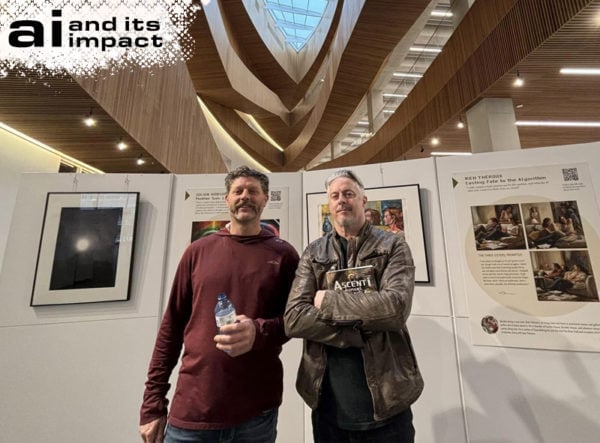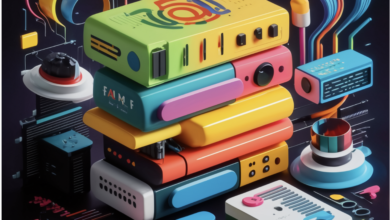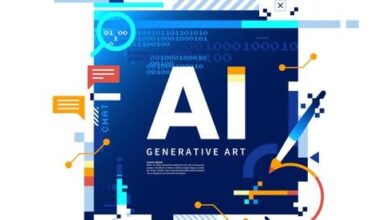Creatives and the machine: Calgary Ascenti symposium explores artificial intelligence and the arts

Julian Hobson and Rich Théroux at Ascenti Symposium on Artificial Intelligence and the Creative Arts, Central Library, Calgary.
Over the course of two days in early April, more than 150 people gathered for the Ascenti Symposium on Artificial Intelligence and the Creative Arts at the Calgary Central Library. The unique conference, which included presentations, panels, workshops, and an art exhibition held on April 5 and 6, attempted to assess the effect artificial intelligence has had, and will continue to have, on the creative arts. The majority of presenters were contributors to the Ascenti-AI project, initiated by Lorene Shyba, the director of Durvile & UpRoute Books. She was inspired to work with trusted Alberta creatives from different disciplines to experiment with AI in their work, after realizing she was receiving submissions for books that had been created with the help of current AI technology. The resulting book – and the basis for the symposium – Ascenti: Humans Opening to AI, is published this month.
As Steve DiPaola, an AI computer scientist and the director of the iVizLab at Simon Fraser University, notes in his introduction to Ascenti, these investigations are about “grappl[ing] with the intricate dance between technology and the human imagination.” The question that came up repeatedly during the two-day event was whether the use of AI assisted these artists, or whether it interfered with their creativity. DiPaola himself sees his own work with AI as a collaborative back-and-forth, but not all presenters embraced the technology as enthusiastically.
Based on the various panel discussions, AI appears to offer the most valued input and assistance when it enhances the lives of artists and creatives by making possible things that might otherwise be difficult or impossible to create.
Dagmar Jamieson works with art and architecture. As someone who has experienced increasing loss of sight since the age of 13, she uses screen readers and AI-describe capabilities to generate images of things such as floor plans that she can no longer draw and see. DerRic Starlight, the creator of the Nuppets and The DerRic Starlight Variety Show, has discovered in AI a useful tool to preserve Indigenous cultural memory and to assist in literacy training. By letting trainees record their stories and then using AI to clean up the transcribed versions of their work, he was able to let stories that might otherwise have remained untold emerge.
It is hard to argue with the usefulness of AI to assist artists in such contexts, or to provide historically marginalized individuals with tools for self-expression. But not all people from marginalized groups had that same reaction.
When author Uche Umezurike prompted AI to collaborate on a writing project, the process highlighted his concerns with the ethics of how AI represents Black masculinity, Black visibility, and family dynamics. In its reworking of Umezurike’s stories, AI removed the agency he had given characters, thus taking away their control of the narrative. It also generated stereotypical images of Black masculinity. And AI turned the sparse simplicity of his work into more ornate prose with limited emotional width. Much of this, he acknowledges, stems from the fact that AI reproduces from the material it is fed, and those stories are often disempowering for minorities. Umezurike’s overriding concerns are who ultimately controls the shape of the narratives generated by AI, and who ultimately has access to these narratives.
Eveline Kolijn, a visual artist and energy activist, used AI to generate images in the style of her own work, and had similar concerns about racial and gender bias. What troubled her with the images that were produced was that AI can generate responses quickly and spawn easy, entertaining content, but little of it, for her, had depth. This was an aspect Glenn Rollans and Rosemary Griebel both identified: the (human) arts are about communicating, questioning, and inspiring, and the emptiness Kolijn noticed makes one wonder whether AI can do this. Most concerning of all, for Kolijn, was the sheer amount of energy that is consumed by the proliferation of AI content and the consumption it drives in the midst of the climate crisis.
Shyba explored the possibility of using AI to generate audiobooks. While AI seemed to handle single-author voices competently, it was unable to present authentic multi-voice experiences that reflected the reciprocity evident in human voices.
Using AI to create and recreate poetry about human mortality, Griebel, a poet, found that AI can harvest responses to death, but does not have any sentient experience of that reality. Because AI is an amalgam of all the voices it harvests, she posits, it has no voice of its own. Yet. That word – yet – punctuated many of the responses throughout the symposium: who knows what AI will be capable of even months from now? An accompanying concern, repeatedly voiced in the course of the presentations, was that AI offers immediate solutions, but these are devoid of the reflection, rumination, and revision that accompanies complex artistic creation.
It was the Saturday afternoon keynote, delivered by Glenn Rollans, publisher of Brush Education and chair of the Association of Canadian Publishers’s Copyright Committee, that perhaps best put these questions in perspective for publishers. Rollans called AI a classic bait and switch that touts its ability to enhance our lives while taking away many of the jobs publishing professionals currently do. He highlighted major concerns with copyright and AI: is it ethical to use writers’ words without proper compensation? AI, he reminded us, gives us control over things we do not know, do not understand, and do not own. AI has no stake in any of the things it does; it has no sense of good faith and can neither tell the truth nor lie. It can record, process, and redirect input, and it can learn to reflect social airs and graces, but as scientist and prominent voice on AI Gary Marcus reminds us: “Charming bullshit is still bullshit.”



